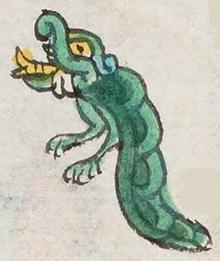Ocuillan (Mdz10v)
This simplex glyph for the place name Ocuillan consists of a green worm or caterpillar (ocuilin). Even if the worm has teeth, this is not the usual way to show the locative suffix -tlan. Interestingly, the worm has two legs with feet, a yellow eye, a yellow forked tongue, and white fangs, making it something of an earth monster. Its body is segmented, and the shades of green on the body vary.
Stephanie Wood
See our Online Nahuatl Dictionary entry for ocuilin to read about worms of sin and worms of Mictlan, the place of the dead. Berdan and Anawalt suggest that this town may refer to the local people, the Ocuilteca, but the norm is that the Ocuilteca (ethnic name) derives from the place name. So, Caterpillar Place might be the better interpretation for this place name. The locative suffix (-tlan) follows a stem ending in l (ocuil-), which means that the t drops away when they are combined, leaving Ocuillan. This worm or caterpillar may be a silkworm. See Wikipedia for images of wild silk worms, which are green and segmented. Silk production was significant in early Mexico, and can still be found as a cottage industry in the Mixteca, state of Oaxaca. Here's a link to an image of a silkworm that shows a face and legs of a sort.
Stephanie Wood
ocuilan__ puo
Ocuillan, pueblo (Ocuilan de Arteaga, state of Mexico, today)
Stephanie Wood
c. 1541, or by 1553 at the latest
Stephanie Wood
worms, caterpillars, gusanos, orugas, fangs, colmillos, nombres de lugares

ocuilin, worm, https://nahuatl.wired-humanities.org/content/ocuilin
-tlan (locative suffix), https://nahuatl.wired-humanities.org/content/tlan
"Where There Are Many Ocuilteca" or "Where There Are Many Caterpillars" (not offering an alternative to Berdan and Anawalt) [Frances Karttunen, unpublished manuscript, used here with her permission.]
"Where There Are Many Ocuilteca" or "Where There Are Many Caterpillars" (Berdan and Anawalt, 1992, vol. 1, 196)
"El Lugar del Gusano" o "El Lugar de la Oruga"
Stephanie Wood
Codex Mendoza, folio 10 verso, https://digital.bodleian.ox.ac.uk/objects/2fea788e-2aa2-4f08-b6d9-648c00..., image 31 of 188.
The Bodleian Libraries, University of Oxford, hold the original manuscript, the MS. Arch. Selden. A. 1. This image is published here under the UK Creative Commons, “Attribution-NonCommercial-ShareAlike 3.0 License” (CC-BY-NC-SA 3.0).




